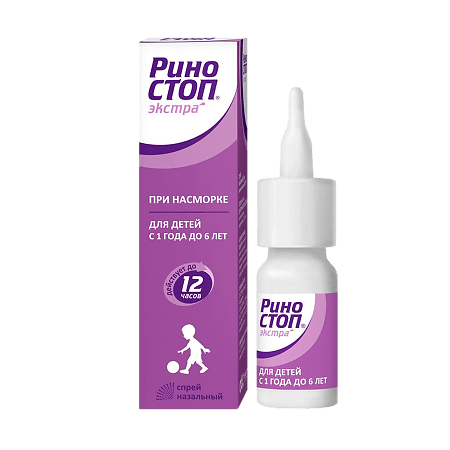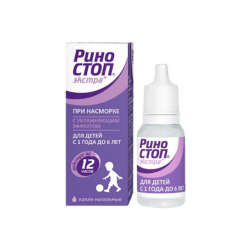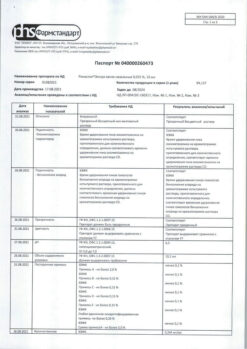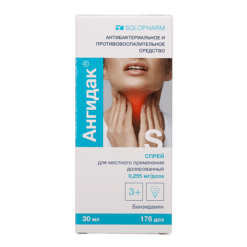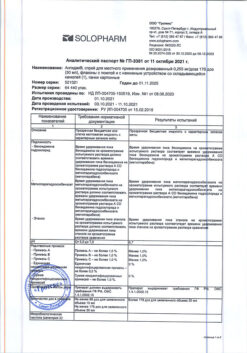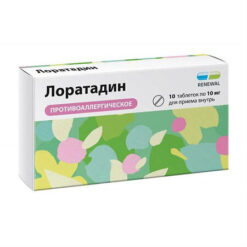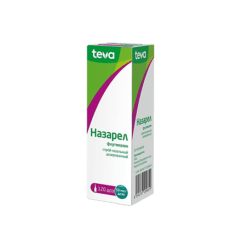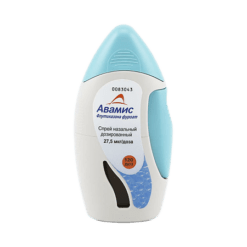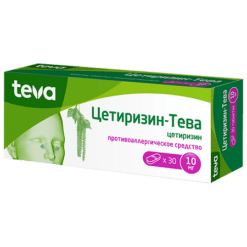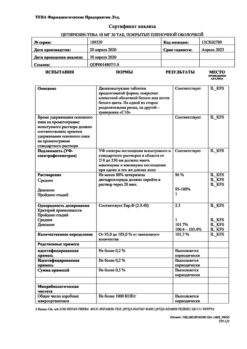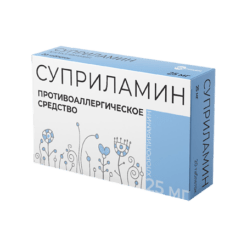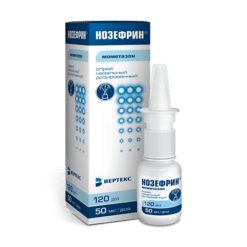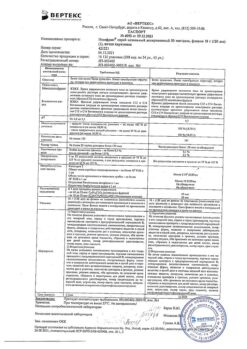No products in the cart.
Rhinostop Extra, spray 0.025% 15 ml
€5.92 €5.27
Description
Pharmacodynamics
Oxymetazoline belongs to the group of local vasoconstrictors (decongestants) with alpha-adrenomimetic action, causes narrowing of blood vessels of nasal mucosa, thus eliminating edema and hyperemia of nasopharyngeal mucosa.
When applied topically to the inflamed nasal cavity mucosa, it reduces its swelling and associated mucus hypersecretion (nasal discharge) which facilitates nasal passageways drainage. It restores nasal breathing.
The elimination of nasal cavity mucous membrane edema helps restore aeration of the sinus cavity, middle ear cavity, which reduces the likelihood of bacterial complications (maxillary sinusitis, sinusitis, otitis media).
In local intranasal application in therapeutic concentrations it does not irritate and does not cause nasal mucous membrane hyperemia.
The drug takes effect quickly, within a few minutes. The duration of action of the drug is up to 12 hours.
Pharmacokinetics
In local intranasal administration, oxymetazoline has no systemic action. The elimination half-life of oxymetazoline when administered intranasally is 35 hours. 2.1% of oxymetazoline is excreted with urine and about 1.1% with feces.
Indications
Indications
Treatment of acute respiratory diseases accompanied by a runny nose;
allergic rhinitis;
vasomotor rhinitis;
to restore drainage in case of inflammation of the paranasal sinuses, eustachitis, otitis media;
to eliminate swelling before diagnostic manipulations in the nasal passages.
Pharmacological effect
Pharmacological effect
Pharmacodynamics
Oxymetazoline belongs to the group of local vasoconstrictors (decongestants) with an alpha-adrenomimetic effect, causing constriction of the blood vessels of the nasal mucosa, thus eliminating swelling and hyperemia of the nasopharyngeal mucosa.
When applied topically to the inflamed mucous membrane of the nasal cavity, it reduces its swelling and concomitant hypersecretion of mucus (nasal discharge), which facilitates the drainage of the nasal passages. Restores nasal breathing.
Elimination of swelling of the nasal mucosa helps restore aeration of the paranasal sinuses and middle ear cavity, which reduces the likelihood of bacterial complications (sinusitis, sinusitis, otitis media).
When used locally intranasally in therapeutic concentrations, it does not irritate or cause hyperemia of the nasal mucosa.
The drug begins to act quickly, within a few minutes. The duration of action of the drug is up to 12 hours.
Pharmacokinetics
When administered locally intranasally, oxymetazoline does not have a systemic effect. The half-life of oxymetazoline when administered intranasally is 35 hours. 2.1% of oxymetazoline is excreted in the urine and about 1.1% in the feces.
Special instructions
Special instructions
Glycerol, which is part of the excipients of the drug Rinostop® Extra, has the property of binding and retaining water, which contributes to additional hydration of the nasal mucosa.
Avoid getting the drug into your eyes.
To avoid the spread of infection, it is necessary to use the drug individually.
Do not exceed the maximum duration and recommended doses when using the drug independently. If there is no improvement or if the symptoms of the disease worsen, you should consult a doctor.
Impact on the ability to drive vehicles and machinery
After a long
use of cold remedies containing oxymetazoline in doses exceeding
recommended, a general effect on the cardiovascular system and
central nervous system. In these cases, care should be taken when
driving vehicles and engaging in other potentially dangerous activities
activities that require increased concentration and speed
psychomotor reactions.
Active ingredient
Active ingredient
Oxymetazoline
Composition
Composition
Composition per 1 ml:
Active ingredient:
Oxymetazoline hydrochloride – 0.25 mg.
Excipients:
Citric acid monohydrate – 0.609 mg;
sodium citrate dihydrate – 3.823 mg;
glycerol – 24.348 mg;
benzalkonium chloride – 0.15 mg;
purified water – up to 1 ml.
Pregnancy
Pregnancy
When used during pregnancy or breastfeeding, do not exceed the recommended dose. The drug can only be used in cases where the potential benefit to the mother outweighs the potential risk to the fetus or child.
Before using the drug, if you are pregnant or think you might be pregnant, or are planning a pregnancy, you should consult your doctor.
Contraindications
Contraindications
– Hypersensitivity to the components of the drug;
– atrophic (dry) rhinitis;
– angle-closure glaucoma;
– condition after transsphenoidal hypophysectomy;
– surgical interventions on the dura mater (in history);
– children’s age up to 1 year.
With caution
With increased intraocular pressure, chronic heart failure, arterial hypertension, angina pectoris; arrhythmias; chronic renal failure; in patients with prostatic hyperplasia with clinical symptoms (urinary retention); severe atherosclerosis; with hyperthyroidism; diabetes mellitus; pheochromocytoma; tachycardia; therapy with monoamine oxidase inhibitors (MAOIs) (including up to 14 days after their discontinuation/within the previous 2 weeks and within 2 weeks after their discontinuation) and tricyclic antidepressants, as well as other drugs that increase blood pressure; porphyria.
If you have one or more of the diseases and conditions listed above, you should consult your doctor before starting use.
Side Effects
Side Effects
Classification of the frequency of side effects (WHO): very common (with a frequency of more than 1/10), often (with a frequency of at least 1/100, but less than 1/10), uncommon (with a frequency of at least 1/1000, but less than 1/100), rare (with a frequency of at least 1/10,000, but less than 1/1000), very rare (with a frequency of less than 1/10,000, including individual reports), frequency unknown (cannot be determined from available data).
Immune system disorders:
Uncommon: hypersensitivity reactions (angioedema, exanthema, itching).
Gastrointestinal disorders:
Rarely: nausea.
Nervous system disorders:
Rarely: headache, dizziness, anxiety, irritability, sleep disturbance (in children), insomnia.
Very rare: fatigue, drowsiness, anxiety, hallucinations, convulsions.
Cardiac disorders:
Rarely: increased blood pressure, palpitations, tachycardia.
Disorders of the respiratory system, chest and mediastinal organs:
Uncommon: burning or dryness of the mucous membranes of the nasal cavity, sneezing, nosebleeds.
In rare cases: after the effect of the drug wears off, a feeling of “stuffiness” in the nose (reactive hyperemia).
Very rare: respiratory arrest (in infants).
Visual disorders:
Rare: blurred vision (if in eyes)
Long-term continuous use of vasoconstrictor drugs can lead to tachyphylaxis, atrophy of the nasal mucosa and recurrent swelling of the nasal mucosa (rhinitis medicamentosa).
If any of the side effects indicated in the instructions get worse or you notice any other side effects not listed in the instructions, tell your doctor.
Interaction
Interaction
The drug slows down the absorption of local anesthetic drugs and prolongs their effect.
When used concomitantly with monoamine oxidase inhibitors (during the previous 2 weeks and within 2 weeks after their discontinuation), tricyclic antidepressants or other drugs that increase blood pressure, an increase in blood pressure may occur.
Co-administration of other vasoconstrictor drugs increases the risk of side effects.
Overdose
Overdose
Clinical signs of intoxication with imidazole derivatives can be nonspecific and unclear, since phases of hyperactivity are replaced by phases of depression of the central nervous system, cardiovascular and respiratory systems.
Symptoms: anxiety, restlessness, hallucinations, convulsions, decreased body temperature, lethargy, drowsiness, coma, constriction or dilation of pupils, fever, sweating, pallor, cyanosis, palpitations, bradycardia, arrhythmia, cardiac arrest, increased blood pressure, decreased blood pressure, nausea, vomiting, respiratory depression, respiratory arrest.
In children, an overdose can cause the development of symptoms from the central nervous system, such as: agitation, convulsions, coma, bradycardia, respiratory arrest, as well as an increase in blood pressure with a subsequent possible decrease in blood pressure.
Treatment: gastric lavage, taking activated carbon (in case of accidental ingestion of the drug); symptomatic.
In case of severe overdose, intensive therapy in a hospital setting is indicated. The use of vasoconstrictors is contraindicated.
In case of overdose, consult a doctor.
Storage conditions
Storage conditions
Store at a temperature not exceeding 25°C.
Shelf life
Shelf life
2 years.
Do not use after expiration date.
Manufacturer
Manufacturer
Pharmstandard-Leksredstva, Russia
Additional information
| Shelf life | 2 years. Do not use after the expiration date. |
|---|---|
| Conditions of storage | Store at the temperature not more than 25 ° C. |
| Manufacturer | Pharmstandard-Leksredstva, Russia |
| Medication form | nasal spray |
| Brand | Pharmstandard-Leksredstva |
Other forms…
Related products
Buy Rhinostop Extra, spray 0.025% 15 ml with delivery to USA, UK, Europe and over 120 other countries.

